Looking to get back into shape after childbirth? You’re in the right place. This article explores the world of postpartum workouts, specifically focusing on effective, 10-minute full-body routines that you can easily incorporate into your daily schedule.
Whether it’s a brisk 20-30 minute walk or a targeted strength training session, we’ve got you covered.
You don’t need hours in the gym to start feeling stronger and more energized. With the right approach, even short workouts can make a significant difference.

Importance of postpartum workout
Getting back into the swing of physical activity after baby isn’t just about regaining your pre-pregnancy body. It’s an important aspect of postpartum care that offers numerous health and wellness benefits.
Health benefits of postpartum workout
Postpartum workouts can pack a punch well beyond calorie burning. Let’s shed some light on the varied health benefits.
- Aids in recovery: Regular exercise can help heal and strengthen your body post childbirth. For example, strength training can improve abdominal and pelvic floor muscles weakened by pregnancy.
- Boosts overall strength: Whether it’s lifting your newborn or pushing a stroller, you’ll find daily tasks easier. Short workouts like a 20-minutes weight lifting session or a 10-minute full-body routine can do the trick.
- Promotes weight management: Postpartum workout puts you back on track to achieve your post-baby weight goals with activities like 30-minute strength training or a 20-minute walk.
- Lowers risk of chronic diseases: Regular exercise contributes to better cardiovascular health and can lower the risk of diseases like diabetes or osteoporosis later in life.
Mental wellness through physical activity
The importance of a postpartum workout isn’t just about the body. Let’s explore how it positively impacts your mental well-being.
- Fights postpartum depression: Exercise stimulates the production of endorphins – the body’s natural mood lifters. Even a simple 20-minute walk or 10-minute stretching can help manage postpartum depression or anxiety.
- Elevates mood and energy levels: Feeling low or drained? A quick bodyweight fitness session or cardio kickboxing is a great energy booster and aids in better sleep.
- Improves self-esteem: As you make progress and achieve fitness goals, you’ll likely experience an increase in self-esteem and self-efficacy. You’d be amazed how a 15-minute full-body strength workout can contribute to a confidence boost.
- Promotes relaxation: Activities like yoga and deep stretching provide a form of moving meditation and can become a peaceful oasis in the chaos of new motherhood.
The primary objective is not to rapidly revert to a pre-baby body, but rather to take care of your physical and mental health with gentle postpartum exercises.
Consult healthcare practitioners for advice if unsure or fearful of injury. Proper care during this vital time can establish long-term health and wellness habits.
Steps to Execute a Complete 10 Minute Postpartum Full Body Workout
After understanding the myriad benefits of postpartum workouts, let’s delve into how you can perform an effective full body workout in just 10 minutes.
Step 1: Full-Body Reach Up/Down With Shoulder Roll and March
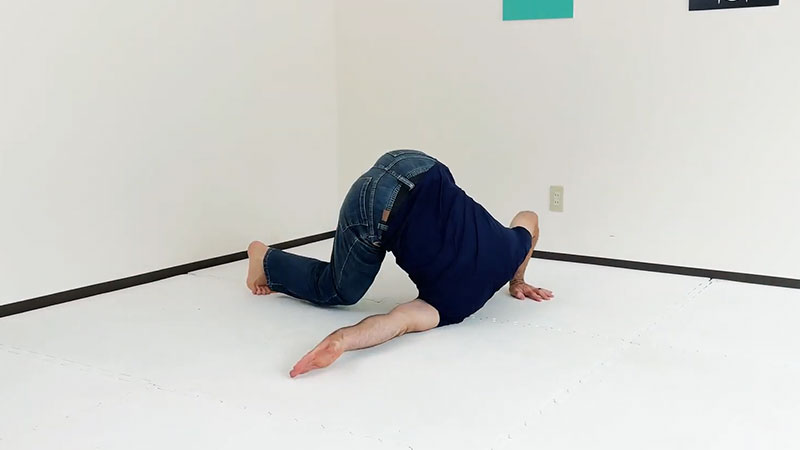
Start by positioning your feet shoulder-width apart. Reach up towards the sky, extending fully, and then fold down, touching your toes or shins. Bring your torso back up to a march, rolling your shoulders back as you do so.
This is a great warm-up exercise that targets multiple muscle groups. Next, perform squats, ensuring your knees don’t extend past your toes.
Then engage in gentle lunges for leg strength. Follow with modified push-ups to strengthen your upper body.
Finish the workout with a light jog or brisk walk for cardiovascular health. Remember, consult your doctor before starting any new exercise routine postpartum.
Step 2: 4-Point Thoracic Rotation
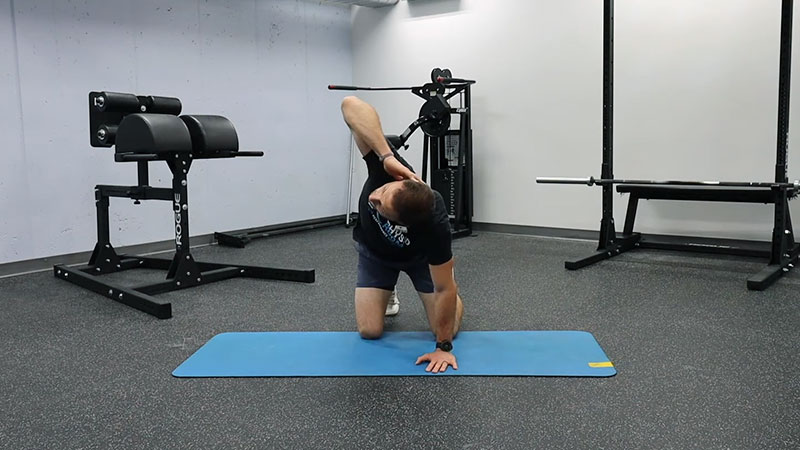
Get into a 4-point position on your hands and knees. Extend your right arm upwards then rotate it beneath your left arm, repeating this movement.
Follow the same steps with your left side. This exercise helps activate both the upper body and core muscles.
Next, perform a squat while holding your baby close to your chest – this not only strengthens lower body muscles but also fosters bonding with the newborn.
Then, do some pelvic tilts which help in rebuilding core strength postpartum. Always listen to your body and take breaks as needed.
Step 3: Glute Bridge
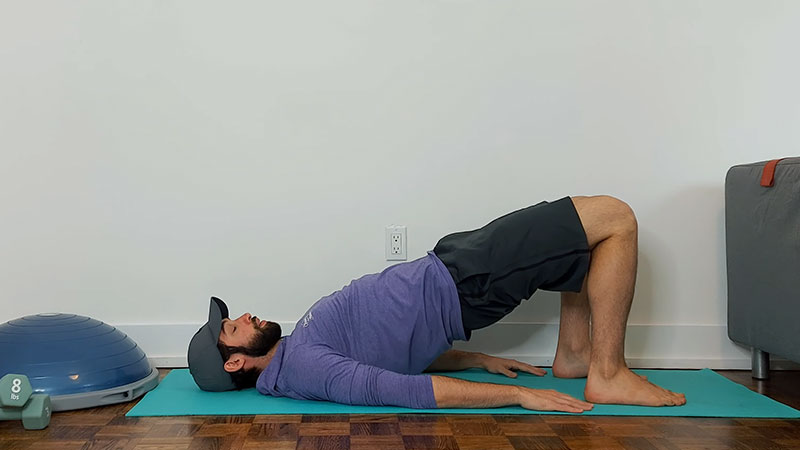
While lying on your back, place your feet flat on the ground and your hands by your sides. Drive your hips up by squeezing your glutes, lower back down, and repeat.
This exercise primarily targets your glutes and hamstrings. But it also engages your core, promoting better posture and reducing the risk of back pain.
This workout is ideal for new mothers as it’s easy to perform and requires no equipment. It can be incorporated into a 10-minute postpartum full body workout routine.
Step 4: Romanian Deadlift
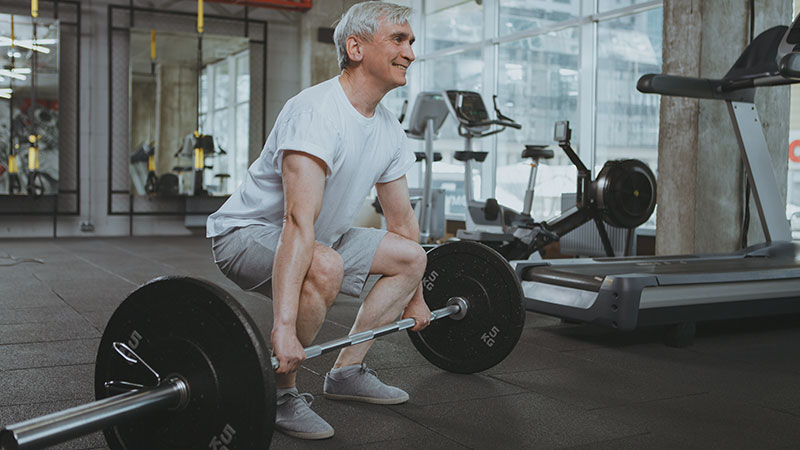
Stand with your feet hip-width apart holding dumbbells in your hands. Hinge forward from your hips, maintaining a slight bend in your knee, to perform the deadlift.
Return to the standing position. This focuses on your glutes and hamstrings. Repeat this move for 10 reps. Next, hold dumbbells at shoulder height and squat down, keeping your knees over your toes.
Rise back up to engage quadriceps and glutes. Repeat for another 10 reps. Finish with a minute of brisk walking or gentle jogging in place to elevate the heart rate. This quick routine strengthens core muscles while boosting postpartum recovery.
Step 5: Bent-Leg Toe Tap
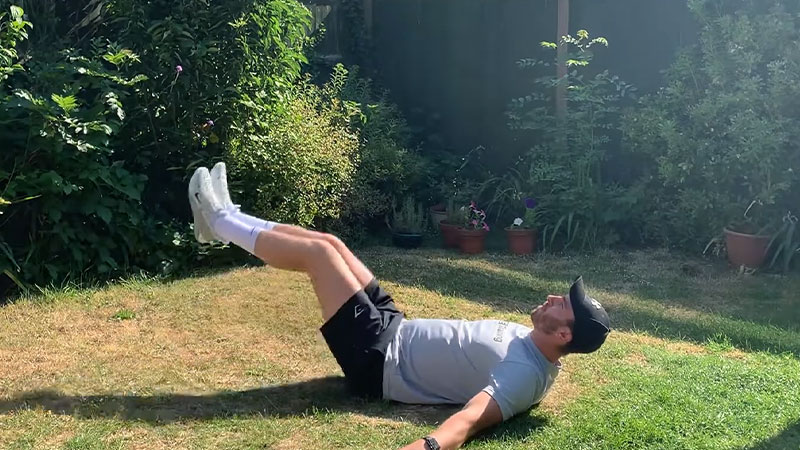
Lie on your back with your knees bent and feet off the ground. Lower one foot to tap the ground and bring it back up, alternating between your feet.
This exercise strengthens your lower abs. Next, perform squats for a full body burn. Stand with feet hip-width apart, lower your body as if sitting on a chair, then stand up again.
This tones your thighs, glutes and core muscles. Remember to breathe evenly throughout the routine and stay hydrated.
Step 6: Bent-Over Row
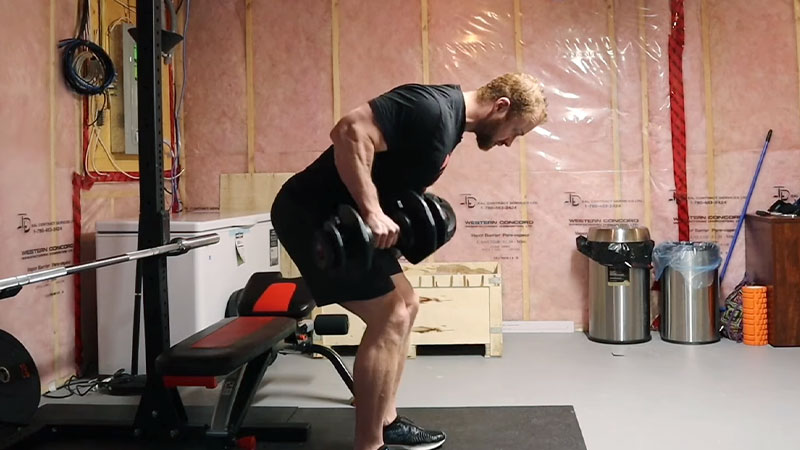
Hold dumbbells in your hands and hinge forward from your hips, maintaining a slight bend in your knee. Row the dumbbells toward your sides, squeezing your back muscles, and then lower them back down.
This targets your back muscles. Continue by performing squats to work your lower body. Stand with feet hip-width apart, bend knees and lower your hips, then rise back up. Repeat this for 10 minutes daily to regain strength and tone postpartum muscles effectively.
Step 7: Shoulder Press

Stand with your feet directly under your hips and dumbbells at shoulder level. Press the weights up until your arms are straight overhead, and then bring them back down to shoulder level.
This exercise engages your shoulders. Continue with squats while holding the weights at shoulder level to engage your lower body.
It’s essential to keep your back straight and knees over toes. End with a short cool-down stretch to prevent muscle stiffness after this quick, effective postpartum workout.
Step 8: Floor Chest Press
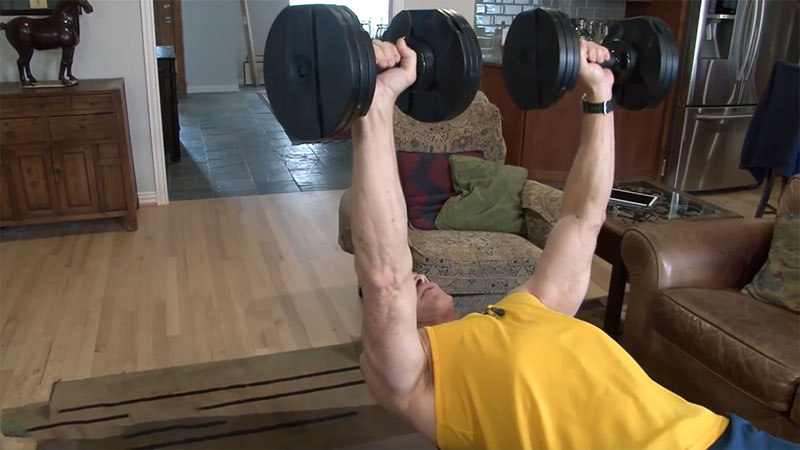
Lie on your back with your knees bent, holding dumbbells in your hands. Press the dumbbells up right above your chest and then lower them down until your elbows lightly touch the ground.
This targets your chest muscles. Next, engage in a bridge pose. Still lying on your back, place the dumbbells on your hips and lift them by squeezing your glutes.
This strengthens your core and pelvic floor. Finish with standing exercises such as side lunges for lower body strength.
Step 9: Supine Transverse Abdominis March
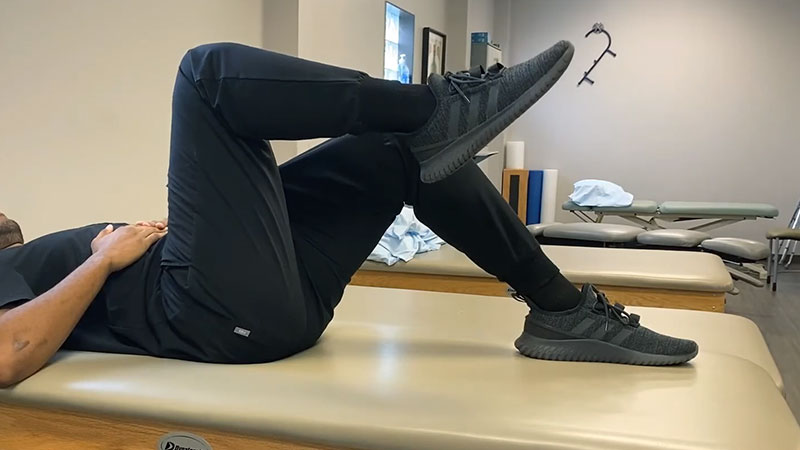
Lie on your back with your knees bent and feet off the ground. Keep your lower back firmly against the ground as you lower one leg down, hover for a moment, and raise it back up, alternating between your legs. This will engage your transverse abdominis, which is crucial in postpartum recovery.
Follow these steps religiously, paying attention to your body’s cues. Never rush into your workouts, and remember, consistency is key in achieving your postpartum fitness goals.
Tips for effective postpartum workouts
Navigating the world of postpartum workouts can be a challenge, but taking the right approach can make all the difference. Here are some top tips to help you get the most out of each sweat session.
Setting Realistic Goals
Begin your post-pregnancy workout routine slowly, recognizing the significant changes your body has undergone.
Start with regular, brief sessions of low intensity exercises such as brisk walking or 20-minute light bodyweight workouts.
Over time, gradually increase both the duration and intensity of these workouts as your body strengthens and adapts to the exercises.
Proper Hydration and Nutrition
Eating nutrient-rich foods before workouts is essential for energy supply and post-exercise recovery.
It’s crucial to stay hydrated, especially for breastfeeding mothers, and to keep water available during exercise. A diet rich in proteins, healthy fats, and balanced macros ensures optimal body function and fueling.
Using the Correct Technique
The text emphasizes the importance of correct form, appropriate equipment, and proper warm-ups and cool-downs when exercising to prevent strain or injury.
It notes that workout videos often provide guidance for these aspects. The text underscores that a good workout isn’t just about intensity but also involves safety and functionality.
Common Challenges and Solutions When Starting Postpartum Workout
Switching to parenthood is no easy task and starting a workout routine when you’re a new mom can feel nearly impossible. However, familiarizing yourself with common challenges and their practical solutions can be a massive help.
Dealing with Lack of Time and Fatigue
It’s no secret that taking care of a newborn is a demanding and time-consuming role that leaves little room for other activities. You may often find yourself too exhausted or busy to squeeze in a workout. Here’s how you can deal:
- Make Workouts Short and Efficient: Focus on quality over quantity and fit in small bursts of exercise throughout the day. Our 10-minute full-body postpartum workout is perfect for this.
- Involve Your Baby: Make baby part of your routine with baby-wearing workouts or during their nap time.
- Ask for Help: Enlist support from your partner, family members or a babysitter to watch your baby while you exercise.
Overcoming Motivation Issues
Staying motivated to follow a workout regimen, particularly when adjusting to life with a newborn, can be challenging. Here are tips to keep your drive alive:
- Set Goal: Start with small, achievable fitness goals that you can gradually increase to keep you motivated.
- Find a Workout Buddy: Pair up with a fellow mama or friend who’s also into fitness, bringing an element of socializing to your workout routine.
- Join a Group or Class: Participating in mom-and-baby fitness classes or joining online fitness communities can provide you with the motivation you need.
- Know Your Body: Understand that your body isn’t the same as it was pre-pregnancy. Adapt your workouts to what your body now needs and is capable of.
- Listen to Your Body: If a particular exercise causes pain or discomfort, don’t force it. Modify it or substitute with an alternative that engages the same muscle group, but with less strain.
- Seek Professional Advice: If discomfort persists, consult your doctor or a physiotherapist. They can provide guidance tailored to your postpartum body and possible conditions such as diastasis recti or pelvic floor issues.
Frequently Asked Questions
What are the benefits of postpartum workouts?
Postpartum workouts aid physical recovery, facilitate weight management, and strengthen the body. Regular exercise can support mental health improvement as it releases helpful neurotransmitters like endorphins, helping sustain a positive outlook amidst the challenges of early parenthood.
What is a suitable daily workout for postpartum health?
The article presents a 10-minute full-body workout guide. It begins with a gentle warm-up and proceeds to two sets of strengthening exercises. This regimen, while beneficial for core muscles, glutes, and overall body movement, can be adjusted per personal comfort and stamina levels. It is advisable to rest and hydrate as needed.
Does this workout require specific equipment?
Not necessarily. The workout is designed to be adaptable, allowing for options with or without equipment. Variety is encouraged for a wholesome postpartum workout. Resources for equipment-free workouts can be found online.
How can I manage workouts on fatigued days?
On days when you’re feeling particularly fatigued or unwell, substitute intense workouts with gentle, paced walks. Remember, the aim is to stay active. Listen to your body and take rest when needed.
Call-to-Action
So there you have it. You’re now equipped with the knowledge to take control of your postpartum fitness journey. Remember, it’s not about the intensity but consistency.
Even on days when you’re feeling fatigued, a simple walk can do wonders. Explore the plethora of online resources available and don’t be afraid to mix up your workouts.
Whether you’ve got equipment or not, there’s a workout out there for you. And if you’re short on time, a quick 10-minute session can still pack a punch.
Listen to your body, adapt as needed, and never hesitate to seek professional advice. Your postpartum journey is unique to you, and it’s okay to take it at your own pace.
So why wait? Start your fitness journey today and embrace the amazing changes your body is capable of!
I am a fitness instructor and I have been in the industry for 9 years. I have a passion for health and fitness.
I am a fitness instructor with over 9 years of experience in the industry. My passion is health and fitness and I would love to share my knowledge with you!